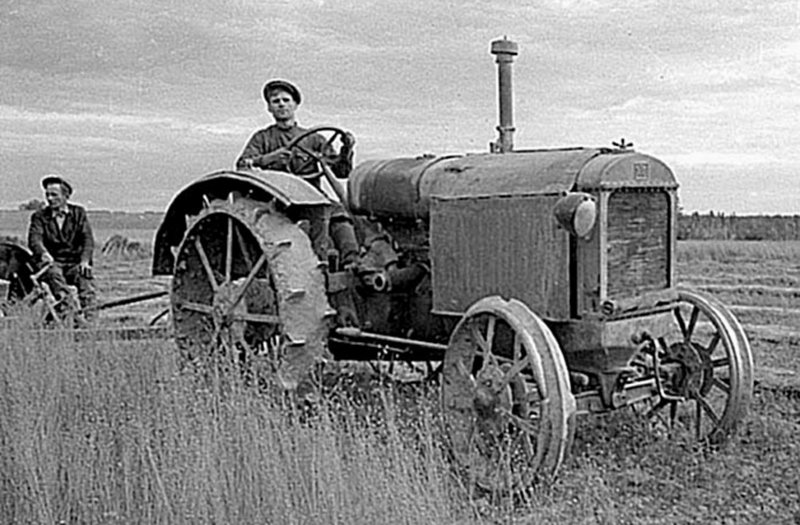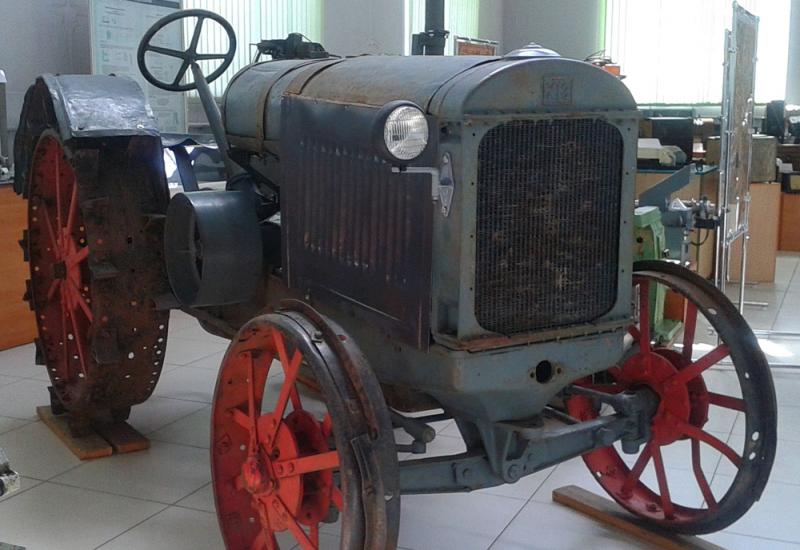In December, the exposition at the State Polytechnic Museum under Igor Sikorsky Kyiv Polytechnic Institute was replenished with a very interesting exhibit - tractor HTZ-15/30. We have got this tractor from the National History Museum of Ukraine.
Accompanying historical information that is provided by the NMU, affirms that "It was received at the National History Museum of Ukraine in December 1958 from Taranyvska secondary School of Lazirkivskyi district in Poltava Region ... After the reorganization in 1958, by the decision of the leading regional organizations, the wheeled tractor "HTZ" №15351 (motor) of pre-war time was handed over for students practical classes of the Taranyvska secondary school of Lazirkivskyi district of Poltava region ... The director of Taranyvska secondary school – Vorona I.Y. transferred this tractor to Kyiv State Historical Museum on October 5, 1958 ".
The tractor HTZ -15/30 was manufactured at the Kharkiv Tractor Plant (HTZ) in 1931-1937 and was the first mass domestic tractor. During 1931-1937 years, there were manufactured about 17,248 of tractors. As the our tractor’s engine is numbered 15351 (single numbered unit of the machine), so while using the data about the number of manufactured units we can determine that this exponent was manufactured in 1932, nearly in October.
Batch production of wheeled tractors “Zaporozhets” with the power of 18 k/s with oil engines (Zaporizhzhia) and caterpillar “Kommunar” with a gas engine with the power of 50 k/s (Kharkiv). But the manufacture output did not meet the needs of agriculture. The USSR government founded the All-Union Commission for the Tractors Testing. There were about 30 of foreign and soviet machines and the commission has chosen as a prototype of a domestic tractor the International American tractor 15/30 manufactured by company “International Harvester”. According to the marking of tractors that was adopted at the beginning of the twentieth century, the numbers after the brand of the tractor mean the power of the tractor in the k/s on a pulley wheel.
It was decided to build a tractor plant in Kharkiv, as the city had highly qualified staff. They had training base and experience of tractor manufacture at Kharkiv locomotive plant. The construction of the Kharkiv tractor plant began in January 1930 and ended on September 21, 1931. The first tractor HTZ-15/30 came down from its conveyor on October 1, 1931.
This tractor was of a simple and classical construction with minimal use of non-ferrous metals and rubber-technical products. Genuine "steel horse" - it had a metal seat and a steering wheel. The main material – is malleable iron. Engine carburetor, inline, 4-stroke, kerosene, four-cylinder, of 31hp capacity. It has aniInflammation from a magnet. The engine started up on a gasoline, but worked on a gas. In order to prevent detonation, the water was supplied during the overload in cylinders. This is due to the installation of three tanks. The engine is furnished with oil pump, filter and reliable oil-based air cleaner. Transmission: three forward speeds, one back speed. Speed from 3.5 to 7.4 km / h. The covered weight is 3011 kg. The tractor had two headlights: one beam ahead, the other back.

The use of a tractor was often limited by a small number of implements with the help of which it worked. That is why the tractor was mainly used for plowing with a special three-wheeled plow. Such operations as harrowing, sowing, getting the crops in was performed with the tractor with horse-drawn tools. Horse-drawn tools could be combined with the tractor by the local mechanics. The tractor was widely used for stationary works and drives of hamsters (so-called transmission). The the tractor plowing inappropriateness caused by a wheeled motor has led to the introduction of crawler tractors. The next model of the mass tractor of the Kharkov tractor plant became a crawler SXTZ-NATI. And in the future, almost all arable tractors in the USSR were crawlers.
The first mass tractor HTZ-15/30 turned out to be unreliable and due to the lack of qualified personnel and technical maintenance, often went off. The biggest complaints concerned the transmission (bearings and gears), it went off almost every month.
“HTZ” was captured into the manufacture of tractors, so the production of spare parts was provided by other enterprises. Such enterprise was the Ivan Lepse plant, which was created on the basis of mechanical workshops of the Kiev Polytechnic Institute (nowadays, the State Polytechnic Museum is located in their building). The workshops mastered the production of spare parts for imported tractors and received the status of a training and mechanical plant of KPI in 1922. The museum was named after the head of the Central Committee of the Metalworkers Union – Ivan Lepse. Afterwards, the plant was excluded from the conformity of the KPI, and it was included into various associations. In 1934 the plant began to manufacture spare parts for domestic tractors.
The small motor operating time of the first tractors, the limited traffic on the roads required specific organizational measures for their use.There were machine-tractor stations (MTS) tied to fields and land. The communal farms took the machines for operating on their fields.
Nowadays, there is only one machine operator (tractor driver) per field. In the early 1930s, the mechanic operated with a trailer (trailer). There was a need in assistance of another person (sometime one or more) till the hydraulic system implementation for grab agricultural equipment and machinery. Another person should help to attach an agricultural machine or a device and should work on it – he was lifting or moving down the plow bodies during the rotation of the machine-tractor unit, he was also regulating the depth of soil cultivation, turning on and off the machines.
The establishment of a batch production of tractors allowed to refuse from the purchase of tractors abroad in 1932. Despite of certain drawbacks in design and specific use, the tractor HTZ-15/30 became the machine that allowed a quick restoration of the agricultural manufacture after 1932-1933 Starvation. It became possible to mechanize the most difficult work on the field, which has been requiring plenty of resources and costs for centuries.
Nowadays, a few units of tractors HTZ-15/30 have been preserved in Ukraine. These tractors are in different safe state are exhibited in Vinnytsia, Dnipro and Poltava historical museums, also at the Museum of Bread (Pereyaslav-Khmelnytskyi). The tractor HTZ-15/30 is definitely a valuable asset of our museum's exposition.

